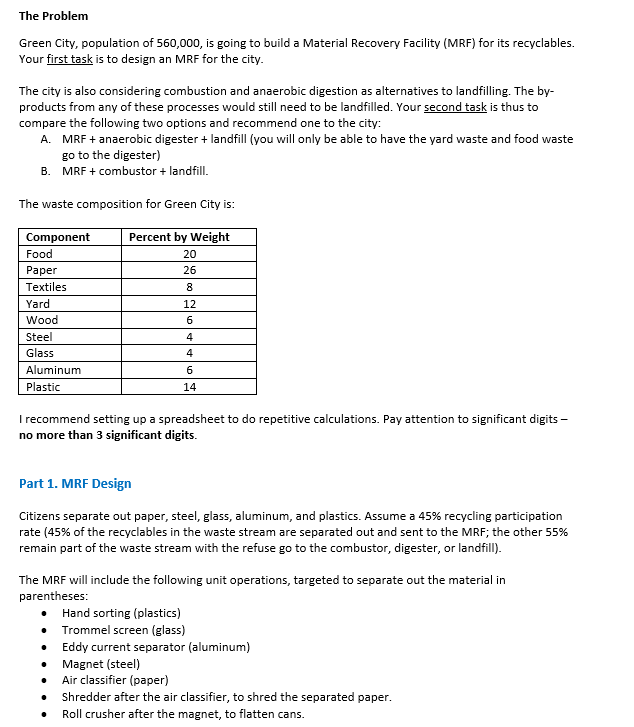The Problem Green City, population of 560,000, is going to build a Material Recovery Facility (MRF) for its recyclables. Your first task is to design an MRF for the city. The city is also considering combustion and anaerobic digestion as alternatives to landfilling. The by- products from any of these processes would still need to be landfilled. Your second task is thus to compare the following two options and recommend one to the city: A. MRF + anaerobic digester + landfill (you will only be able to have the yard waste and food waste go to the digester) B. MRF + combustor + landfill. The waste composition for Green City is: Component Percent by Weight Food 20 Paper 26 Textiles 8 Yard 12 Wood 6 Steel 4 Glass 4 Aluminum Plastic 6 14 I recommend setting up a spreadsheet to do repetitive calculations. Pay attention to significant digits - no more than 3 significant digits. Part 1. MRF Design Citizens separate out paper, steel, glass, aluminum, and plastics. Assume a 45% recycling participation rate (45% of the recyclables in the waste stream are separated out and sent to the MRF; the other 55% remain part of the waste stream with the refuse go to the combustor, digester, or landfill). The MRF will include the following unit operations, targeted to separate out the material in parentheses: Hand sorting (plastics) • Trommel screen (glass) • Eddy current separator (aluminum) Magnet (steel) Air classifier (paper) Shredder after the air classifier, to shred the separated paper. • Roll crusher after the magnet, to flatten cans.
The Problem Green City, population of 560,000, is going to build a Material Recovery Facility (MRF) for its recyclables. Your first task is to design an MRF for the city. The city is also considering combustion and anaerobic digestion as alternatives to landfilling. The by- products from any of these processes would still need to be landfilled. Your second task is thus to compare the following two options and recommend one to the city: A. MRF + anaerobic digester + landfill (you will only be able to have the yard waste and food waste go to the digester) B. MRF + combustor + landfill. The waste composition for Green City is: Component Percent by Weight Food 20 Paper 26 Textiles 8 Yard 12 Wood 6 Steel 4 Glass 4 Aluminum Plastic 6 14 I recommend setting up a spreadsheet to do repetitive calculations. Pay attention to significant digits - no more than 3 significant digits. Part 1. MRF Design Citizens separate out paper, steel, glass, aluminum, and plastics. Assume a 45% recycling participation rate (45% of the recyclables in the waste stream are separated out and sent to the MRF; the other 55% remain part of the waste stream with the refuse go to the combustor, digester, or landfill). The MRF will include the following unit operations, targeted to separate out the material in parentheses: Hand sorting (plastics) • Trommel screen (glass) • Eddy current separator (aluminum) Magnet (steel) Air classifier (paper) Shredder after the air classifier, to shred the separated paper. • Roll crusher after the magnet, to flatten cans.
Solid Waste Engineering
3rd Edition
ISBN:9781305635203
Author:Worrell, William A.
Publisher:Worrell, William A.
Chapter9: Toward Integrated Resources Management—environmental, Political, And Economic Issues
Section: Chapter Questions
Problem 9.1P
Question

Transcribed Image Text:The Problem
Green City, population of 560,000, is going to build a Material Recovery Facility (MRF) for its recyclables.
Your first task is to design an MRF for the city.
The city is also considering combustion and anaerobic digestion as alternatives to landfilling. The by-
products from any of these processes would still need to be landfilled. Your second task is thus to
compare the following two options and recommend one to the city:
A. MRF + anaerobic digester + landfill (you will only be able to have the yard waste and food waste
go to the digester)
B. MRF + combustor + landfill.
The waste composition for Green City is:
Component
Percent by Weight
Food
20
Paper
26
Textiles
8
Yard
12
Wood
6
Steel
4
Glass
4
Aluminum
Plastic
6
14
I recommend setting up a spreadsheet to do repetitive calculations. Pay attention to significant digits -
no more than 3 significant digits.
Part 1. MRF Design
Citizens separate out paper, steel, glass, aluminum, and plastics. Assume a 45% recycling participation
rate (45% of the recyclables in the waste stream are separated out and sent to the MRF; the other 55%
remain part of the waste stream with the refuse go to the combustor, digester, or landfill).
The MRF will include the following unit operations, targeted to separate out the material in
parentheses:
Hand sorting (plastics)
• Trommel screen (glass)
•
Eddy current separator (aluminum)
Magnet (steel)
Air classifier (paper)
Shredder after the air classifier, to shred the separated paper.
•
Roll crusher after the magnet, to flatten cans.
Expert Solution
This question has been solved!
Explore an expertly crafted, step-by-step solution for a thorough understanding of key concepts.
This is a popular solution!
Trending now
This is a popular solution!
Step by step
Solved in 2 steps

Recommended textbooks for you

Solid Waste Engineering
Civil Engineering
ISBN:
9781305635203
Author:
Worrell, William A.
Publisher:
Cengage Learning,

Solid Waste Engineering
Civil Engineering
ISBN:
9781305635203
Author:
Worrell, William A.
Publisher:
Cengage Learning,